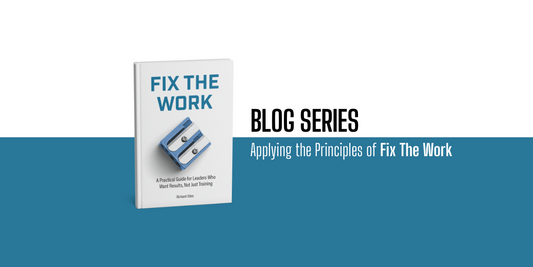Why Learning Theory Doesn’t Fix Work
Richard SitesShare This Post
Learning theory has its place. It can be useful for understanding how people process information, how motivation works, and what conditions support growth. But inside the workplace, theory is often treated as something it was never meant to be: a substitute for solving actual problems.
Teams reference learning theory to justify decisions. They cite models in presentations. They point to frameworks as evidence that the design is sound. But the reality on the ground tells a different story. Courses are completed, yet behavior does not change. Programs are launched, yet the same mistakes keep happening. Engagement is high, but performance stays flat.
That is because learning theory does not fix broken workflows. It does not make expectations clearer. It does not help a manager give better feedback or a frontline team use a tool more effectively. These things live inside the work, not in the learning. And when training is built around theory instead of need, it risks becoming more polished than useful.
The gap between theory and practice is not new. It has been discussed for decades in the learning field. But in many organizations, the gap is still growing. That is partly because training has become easier to produce than ever. Templates, platforms, and tools make it simple to build something that looks legitimate. When a request comes in, teams can quickly respond with a structured, theory-backed solution. And that solution often gets approved, because it checks the boxes leadership has learned to look for.
But checking boxes is not the same as changing outcomes.
The real work happens inside moments. A technician deciding whether to take a shortcut. A new hire choosing how to handle a customer. A team lead trying to prioritize five tasks with unclear direction. These are not moments where theory applies. They are moments where clarity, support, and decision cues matter. If the learning solution does not meet people inside those moments, then it does not matter how well it maps to a taxonomy.
This is where many learning teams get stuck. They build content that teaches well but does not transfer. They align to abstract models but ignore friction in the real workflow. They prioritize coverage over usefulness. And the people they are building for do not say anything. They take the training. They pass the quiz. Then they go back to doing the job the way they always have.
If the goal is performance, then the focus has to shift. The work itself needs to be the starting point. What are people being asked to do? Where are they getting stuck? What do they need in the moment to succeed? These are not theoretical questions. They are practical ones. And the solutions that emerge from them often look nothing like traditional instruction.
Sometimes people need a checklist. Sometimes they need a better way to surface feedback. Sometimes they need a script, a prompt, a visual reference, or a quicker path to support. Sometimes the system around them needs to change before anything else will. These kinds of solutions do not come from academic models. They come from observing the work, listening to the people doing it, and building something that fits inside that context.
None of this means theory is useless. It can guide thinking. It can sharpen instincts. But it should not drive design decisions on its own. It should not be used to justify products that do not help. And it should never outweigh what people actually need to do the job.
Learning theory explains how people learn. But learning is not the same as doing. Performance is shaped by context, not just cognition. And when the pressure is on, what matters most is not whether someone remembers what they learned. What matters is whether they can do what the job requires—right now, in real conditions, with real constraints.
So if you are facing a performance problem, do not reach for a model. Start with the moment. Find the friction. Understand the workflow. Build something that works there.
And if the solution never shows up on a learning theory chart, that probably means you are headed in the right direction.





